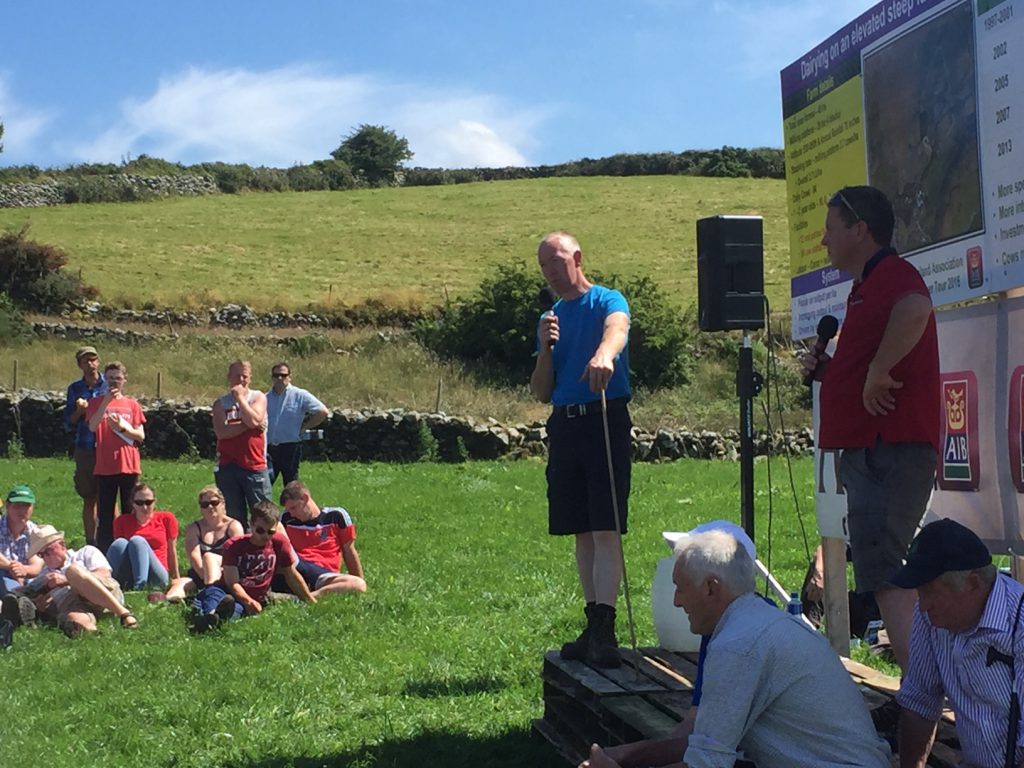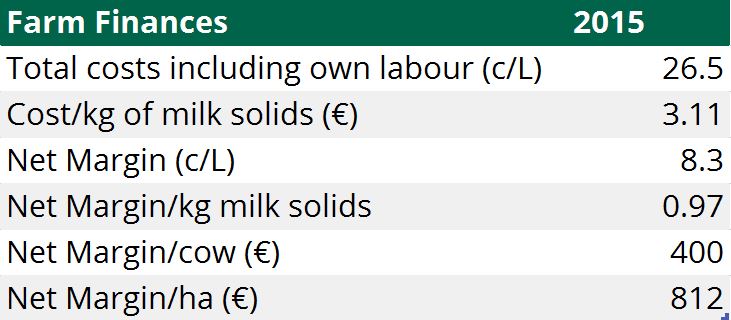Conor Creedon milks a herd of 94 crossbred cows on the Cork-Kerry border in an area known locally as Sliabh Luachra or ‘the Rushy Hill’.
This week, almost 400 farmers visited his farm as part of the Irish Grassland Association’s dairy summer tour.
Creedon inherited the farm with a herd of 20 Holstein and British Friesian cows in 1997 and since then he has made major changes to the enterprise.
Despite the milking block ranging from 550 to 900 feet above sea level, Creedon has placed a major emphasis on grassland management.
And in 2015, the milking platform (26 hectares) grew 15.5t of grass per hectare, while the out farm (17 hectares) grew over 13t per hectare.
However, Creedon told the crowds in attendance that a great deal of work was involved getting the ground up to this level of production.
The process of land improvement began in 1997, he said, and 10-to-12 acres were targeted for improvement every spring at a cost ranging from €1,000-1,300/ac.
As more and more land was reclaimed from the mountain side, Creedon said that he started to increase cow numbers in response to the additional grass grown on farm, while weaning off both pre-existing the beef and sheep enterprises.
In 2005, Creedon milked 58 cows and over the past 11 years he has built cow numbers up gradually to the current herd of 94.
Given the location of Creedon’s farm spring management can be quite difficult, but he joked that he operates the ‘Kerry style’ of spring grazing.
Calving begins on the farm from the middle of February and cows are turned out to grass as soon as weather permits.
Creedon aims to have at least 50% of the cows calved by March 1 and this year 96% of the cows calved within six weeks.
He added that on-off grazing works exceptionally well during the spring time, with cows turned out to grass for two-to-three hours in the morning and evening during wet conditions.
We are trying to graze as much grass as we can without doing too much damage. Last year, Creedon got 11 grazings off ever paddock on the milking platform and he said if it wasn’t for early spring turnout this would not have been possible.
The majority of silage used on the farm is harvested from the out farm, but he added that between 15-20% of silage is taken as surplus bales from the milking platform. Creedon said that measuring grass is particularly important on his farm and it is necessary to measure every five days as some of the paddocks are too steep to mow or top.
He said that the pre-grazing covers cannot go over 1,500-1,600kg on some of the stepper paddocks on the farm.
And as a result, these paddocks are prioritised for grazing, while other more manageable are taken as surplus bales.
Creedon explained that one of the key aims on his farm is to have a 500kg cow, producing 500kg of milk solids from a concentrate input of 500kg.
To achieve this goal, he has moved to Jersey cross-breeding in recent years in a bid to increase the solids production of his herd.
Previously, Creedon had been using New Zealand Friesian genetics to breed a cow to suit his grass-based system, but he felt they were lacking that little bit extra.
And, on the back of a lower milk price in 2009, Creedon made the decision to start cross breeding to improve the milk solids production of his herd.
This decision is already starting to pay off for the Kerry-based farmer, as he said the extra solids produced so far this year has been worth an extra 6c/L on top of the base milk price of 22c/L. Along with higher milk solids, Creedon also said that the cows on his farm tended to calve and go back in calf easier since he introduced the Jersey genetics.
Like many farmers who have gone down the cross breeding route, Creedon thought long and hard about future sire choice.
After much thought, Creedon said that he made the decision to go back the route of high EBI Holsteins as he felt the problems with EBI had been ironed out in recent years.
However, he admitted that he looks closely at the breakdown of each bulls EBI figure and has focused on the maintenance sub-index to ensure that the resulting cows are able to with stand his system.
“The EBI is fine but I look at the compounds in it. I am not in the business of breeding a cow with an EBI of €250.
“I want a cow that is able to last in my system and keep the replacement rate of the herd low,” he said.
Grassland management
Measuring every five days to manage surpluses
500 is the magic number for Creedon’s cows
Whats the next step after cross breeding?
Video: Take a closer look at the Jersey-cross cows




